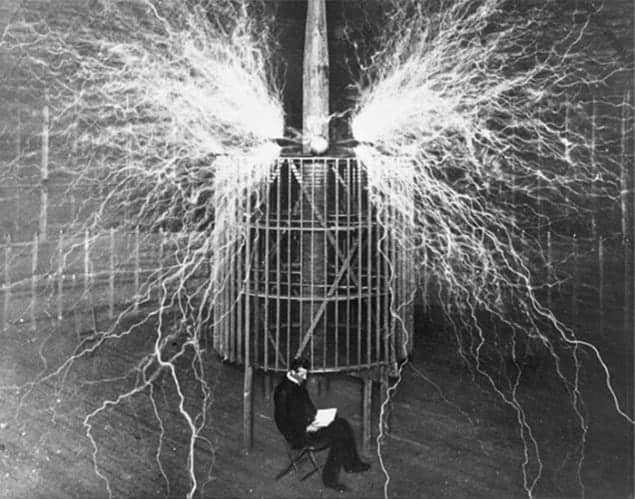Tesla: Inventor of the Electrical Age, W Bernard Carlson, (2013) Princeton University Press £19.95/$29.95hb 520pp

The scientist and inventor Nikola Tesla was born in 1856 to Serbian parents living in the town of Smiljan, in what is now Croatia. Inspired by his mother, the young Tesla was an avid tinkerer who tried to build an airship when he was still a child. He also had an overly vivid imagination, and initially lived in the shadow of his older brother, Dane. After Dane was killed in an accident, seven-year-old Nikola was expected to follow in his father’s footsteps and become a priest of the Serbian Orthodox Church. A few years later, however, Tesla fell seriously ill with cholera, and on his apparent deathbed he extracted from his father permission to pursue a technical education. He quickly got better.
Unfortunately, Tesla’s subsequent history – his inventions of the two – phase electric motor and the Tesla coil (among other things), his long feud with Thomas Edison and his later slide into obscurity – is related unevenly in W Bernard Carlson’s new biography. Although Tesla: Inventor of the Electrical Age starts out reasonably well, telling the story of Tesla’s early life and early inventions, problems develop quickly.
The book’s first sign of trouble follows Tesla’s 1875 move to Graz, Austria. There, at the Joanneum Technical School, he received his first formal introduction to what was then known about electricity. It was in Graz that Tesla made his first attempts to invent an alternating-current (AC) motor, in contrast to the direct-current (DC) motors that were in use at the time. But Carlson’s accounts of the technical details of Tesla’s work are given in terms of Tesla’s understanding rather than a modern view, and they are often difficult to follow in detail.
After Graz, Tesla continued his education in Prague, followed by Budapest. There he acquired a sidekick, Antal Szigeti, and had his first big idea: a rotating magnetic field in an AC motor. He and Szigeti then went to Paris, where they joined the company started by Edison, and Tesla learned the difference between his mental image of an AC motor and the problems associated with the real thing. In 1884 he moved again, this time to New York, where he worked at the Edison Machine Works. He developed an arc-lighting system there, but Edison was more interested in incandescent lighting, and the two soon parted ways.
In the years that followed, Tesla invented a series of electrical devices, including a thermoelectric motor and a pyromagnetic generator. His work attracted the attention of wealthy financiers as well as technologists; Alfred S Brown, superintendent of Western Union’s New York Metropolitan District, backed him in this period, as did Charles F Peck, a lawyer from Englewood, New Jersey. With their help, Tesla developed the idea of a polyphase AC motor, which became his first big invention. He presented a lecture on his new motor to the American Institute of Electrical Engineers on 16 May 1888. It was a big hit, and afterwards he moved to Pittsburgh, where the entrepreneur and inventor George Westinghouse put him to work on improving his polyphase motor.
The Westinghouse Company built between 500 and 1000 Tesla motors, destined for use primarily in streetcars and mining machinery. Westinghouse also licensed Tesla’s US patents for a polyphase AC induction motor and built huge power stations to supply these motors with electricity. Edison, for his part, built DC power stations and championed the use of DC, but Tesla’s ideas were superior and won out in the end. It is curious that very little is said in this book about the epic struggle between Tesla’s AC ideas and Edison’s DC devices.
In any case, Tesla quit Westinghouse in 1889 and returned to New York, where Szigeti had been working all along. (As a side note, Szigeti may have been more than just Tesla’s friend and assistant; Tesla had long – standing friendships with several men, Szigeti included, and Carlson speculates, without reaching a firm conclusion, that he was homosexual.) In New York, Tesla undertook to repeat the experiments of Heinrich Hertz, which had confirmed James Clerk Maxwell’s prediction of electromagnetic waves. Fiddling with a Hertz-like apparatus for producing waves, he soon hit upon what became known as the Tesla coil – a machine that generated high-frequency, high-voltage signals at a low current. He began giving lectures in which he thrilled his public with high-power demonstrations of electrical effects. Remarkably, he was seldom injured during these spectacular shows.
The apex of Tesla’s career came in 1893, when the head of the effort to harness the power of Niagara Falls, Edward Dean Adams, awarded to Westinghouse the contract to build generators for the power plant. Adams’ decision was influenced by Tesla’s polyphase AC ideas, which he admired – albeit not enough to keep him from hedging his bets. Although Westinghouse got the power plant, its great rival, the Edison General Electric Company, was chosen to build the lines that would transmit the power to Buffalo, New York, 20 miles away.
“The success of the project at Niagara Falls,” Carlson writes, “cemented Tesla’s reputation as one of America’s leading inventors.” But after his Niagara triumph, Tesla’s long descent into obscurity began, and unfortunately Carlson’s book descends with him.
Tesla’s principal invention of this later period was a scheme to send information and power worldwide by means of waves in the Earth: not the radio waves of his rival Guglielmo Marconi, but underground standing waves generated by huge devices. However, Tesla was never quite able to finance the construction of these devices, and in the book we learn of his increasingly desperate attempts to raise funds to support this and other “inventions” – all of them apparently unsuccessful.
Carlson sees Tesla’s information-transmission “invention” as anticipating the World Wide Web, and says there are individuals even today investigating whether Tesla’s ideas might work. But as even Carlson admits, there is a “disjunction between what Tesla thought…and how the Earth actually functions”. Disjunction, indeed: this idea, like many of Tesla’s schemes, was pure fantasy.
Initially, Carlson is somewhat sceptical of Tesla’s wilder notions. In the end, though, he is dragged along by Tesla’s magic, and the second half of his book suffers for it, sliding off into the sort of nonsense that Tesla’s die-hard fans (and there are a lot of them out there) really love. This is a pity, because Tesla did have some very good ideas, especially early on. All told, this is not a very good book.



